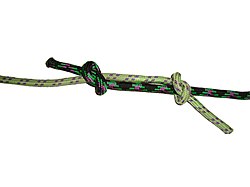Difference between revisions of "Translations:AY Honors/Knot/Fisherman's bend/3/es"
From Pathfinder Wiki
m (FuzzyBot moved page Translations:Adventist Youth Honors Answer Book/Knot/Fisherman's bend/3/es to Translations:AY Honors/Knot/Fisherman's bend/3/es without leaving a redirect: Part of translatable page "Adventist Youth Honors Answer Book/Knot/Fisherman's bend") |
Latest revision as of 14:14, 8 September 2021
| Nudo pescador |
|---|
|
Uso: El nudo del pescador es una vuelta especializada. Se compone de dos nudos simples envueltos alrededor de uno al otro. Funciona bien para la unión de las líneas finas, duras o resbaladizas.
Se requiere poca destreza para atarla y se utiliza usualmente en materiales difíciles. Cuando se aprieta, se hace bastante compacto y los extremos libres pueden ser cortados muy cerca del nudo. Esto hace que sea muy útil para una línea de pesca porque es menos probable que atasque una caña de pescar como lo haría muchas otras vueltas, y es más fácil para atar con manos frías y húmedas.
Cómo amarrar:
|

